#indigenous conservation
Explore tagged Tumblr posts
Text
From the article:
A recent report by Indigenous Environmental Network, or IEN, and Oil Change International, or OCI, found that Indigenous-led resistance to 21 fossil fuel projects in the U.S. and Canada over the past decade has stopped or delayed an amount of greenhouse gas pollution equivalent to at least one-quarter of annual U.S. and Canadian emissions.
#indigenous conservation#indigenous rights#climate change#hope#good news#global warming#environment#greenhouse gases#sustainability#fossil fuels#pipelines#resistance
2K notes
·
View notes
Text
Unchecked logging and quarrying of rocks from streambeds in Bangladesh’s Chittagong Hill Tracts led to springs drying up and populations of putitor mahseer fish, an endangered species, disappearing.
The situation was worsened by climate change impacts, characterized here by a more intense dry season during which even streams that once ran year-round now dry up.
A project launched in 2016 and backed by USAID and the UNDP is working with Indigenous communities to reverse this decline, starting with efforts to cut down on logging and quarrying.
As a result of these efforts, areas where forests have been conserved have seen the flow of springs stabilize and populations of putitor mahseer and other fish revive.
#good news#science#environmentalism#indigenous conservation#indigenous people#nature#environment#animals#endangered animals#endangered species#fish#putitor mahseer fish#bangladesh#conservation
116 notes
·
View notes
Text
If you aren't following the news here in the Pacific Northwest, this is a very, very big deal. Our native salmon numbers have been plummeting over the past century and change. First it was due to overfishing by commercial canneries, then the dams went in and slowed the rivers down and blocked the salmons' migratory paths. More recently climate change is warming the water even more than the slower river flows have, and salmon can easily die of overheating in temperatures we would consider comfortable.
Removing the dams will allow the Klamath River and its tributaries to return to their natural states, making them more hospitable to salmon and other native wildlife (the reservoirs created by the dams were full of non-native fish stocked there over the years.) Not only will this help the salmon thrive, but it makes the entire ecosystem in the region more resilient. The nutrients that salmon bring back from their years in the ocean, stored within their flesh and bones, works its way through the surrounding forest and can be traced in plants several miles from the river.
This is also a victory for the Yurok, Karuk, and other indigenous people who have relied on the Klamath for many generations. The salmon aren't just a crucial source of food, but also deeply ingrained in indigenous cultures. It's a small step toward righting one of the many wrongs that indigenous people in the Americas have suffered for centuries.
#salmon#dam removal#fish#animals#wildlife#dams#Klamath River#Klamath dams#restoration ecology#indigenous rights#Yurok Tribe#Karuk Tribe#nature#ecology#environment#conservation#PNW#Pacific Northwest
19K notes
·
View notes
Text
Biden creates a new national monument near the Grand Canyon - https://www.npr.org/2023/08/08/1192622716/biden-national-monument-grand-canyon-arizona
The move protects lands that are sacred to indigenous peoples and permanently bans new uranium mining claims in the area. It covers nearly 1 million acres.
—
"It will help protect lands that many tribes referred to as their eternal home, a place of healing and a source of spiritual sustenance," she said. "It will help ensure that indigenous peoples can continue to use these areas for religious ceremonies, hunting and gathering of plants, medicines and other materials, including some found nowhere else on earth. It will protect objects of historic and scientific importance for the benefit of tribes, the public and for future generations."
—
The new national monument will be called Baaj Nwaavjo I'tah Kukveni Grand Canyon National Monument. According to the Grand Canyon Tribal Coalition that drafted a proposal for the monument, "Baaj Nwaavjo" means "where tribes roam" in Havasupai, and "I'tah Kukveni" translates to "our ancestral footprints" in Hopi.
all land is sacred (and should be returned) but this is good news.
#indigenous#native american#ndn#arizona#grand canyon#climate change#nature#good news#land conservation and preservation#hopi#havasupai
7K notes
·
View notes
Text
In the Willamette Valley of Oregon, the long study of a butterfly once thought extinct has led to a chain reaction of conservation in a long-cultivated region.
The conservation work, along with helping other species, has been so successful that the Fender’s blue butterfly is slated to be downlisted from Endangered to Threatened on the Endangered Species List—only the second time an insect has made such a recovery.
[Note: "the second time" is as of the article publication in November 2022.]
To live out its nectar-drinking existence in the upland prairie ecosystem in northwest Oregon, Fender’s blue relies on the help of other species, including humans, but also ants, and a particular species of lupine.
After Fender’s blue was rediscovered in the 1980s, 50 years after being declared extinct, scientists realized that the net had to be cast wide to ensure its continued survival; work which is now restoring these upland ecosystems to their pre-colonial state, welcoming indigenous knowledge back onto the land, and spreading the Kincaid lupine around the Willamette Valley.
First collected in 1929 [more like "first formally documented by Western scientists"], Fender’s blue disappeared for decades. By the time it was rediscovered only 3,400 or so were estimated to exist, while much of the Willamette Valley that was its home had been turned over to farming on the lowland prairie, and grazing on the slopes and buttes.
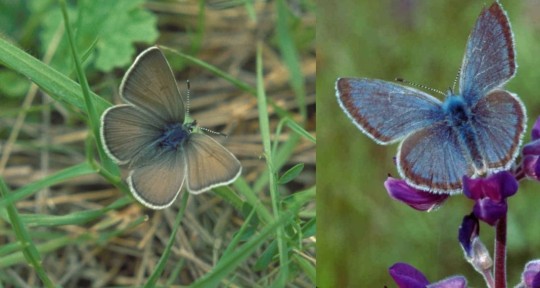
Pictured: Female and male Fender’s blue butterflies.
Now its numbers have quadrupled, largely due to a recovery plan enacted by the Fish and Wildlife Service that targeted the revival at scale of Kincaid’s lupine, a perennial flower of equal rarity. Grown en-masse by inmates of correctional facility programs that teach green-thumb skills for when they rejoin society, these finicky flowers have also exploded in numbers.
[Note: Okay, I looked it up, and this is NOT a new kind of shitty greenwashing prison labor. This is in partnership with the Sustainability in Prisons Project, which honestly sounds like pretty good/genuine organization/program to me. These programs specifically offer incarcerated people college credits and professional training/certifications, and many of the courses are written and/or taught by incarcerated individuals, in addition to the substantial mental health benefits (see x, x, x) associated with contact with nature.]
The lupines needed the kind of upland prairie that’s now hard to find in the valley where they once flourished because of the native Kalapuya people’s regular cultural burning of the meadows.
While it sounds counterintuitive to burn a meadow to increase numbers of flowers and butterflies, grasses and forbs [a.k.a. herbs] become too dense in the absence of such disturbances, while their fine soil building eventually creates ideal terrain for woody shrubs, trees, and thus the end of the grassland altogether.
Fender’s blue caterpillars produce a little bit of nectar, which nearby ants eat. This has led over evolutionary time to a co-dependent relationship, where the ants actively protect the caterpillars. High grasses and woody shrubs however prevent the ants from finding the caterpillars, who are then preyed on by other insects.
Now the Confederated Tribes of Grand Ronde are being welcomed back onto these prairie landscapes to apply their [traditional burning practices], after the FWS discovered that actively managing the grasslands by removing invasive species and keeping the grass short allowed the lupines to flourish.
By restoring the lupines with sweat and fire, the butterflies have returned. There are now more than 10,000 found on the buttes of the Willamette Valley."
-via Good News Network, November 28, 2022
#butterflies#butterfly#endangered species#conservation#ecosystem restoration#ecosystem#ecology#environment#older news but still v relevant!#fire#fire ecology#indigenous#traditional knowledge#indigenous knowledge#lupine#wild flowers#plants#botany#lepidoptera#lepidopterology#entomology#insects#good news#hope
4K notes
·
View notes
Text
so I found this really cool website that sells native seeds- and you might be asking me "snekdood, haven't you posted an entire list of websites that sell native wildflower seeds that you're going to add on to soon?" and yes that's true, but that's not the kind of native seed im talking about rn.
see, on my quest to find websites that sell native wildflowers, I came across this dope ass website that sells seeds that have been farmed and harvested by ntv people traditionally, i'll let the website do the talking:



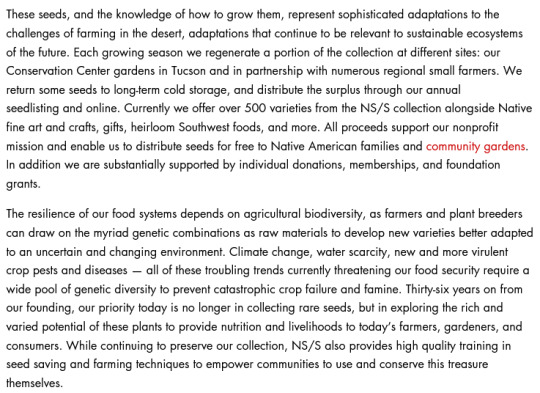
so anyways this is the coolest website ever. you can find the wild relatives of chiles on here called chiltepines, you can find different colors of corn and cool squash's, and every seed from whichever farm has it's own lil origin story written about it. you can also find other veggies here that are already commercially available to help fund and support this organization. as well as there being a cool gift shop with a lot of art made by different native folk from all around as well as cookbooks, jewelry, pottery, weavings, and clearly plenty more:

as well as a pantry?? with premade soup mixes??? and i really want to try them now??????

anyways I think its worth snoopin' around bc I'm almost positive you'll see something you think is cool (oh also if you happen to have some seeds passed down from ur family too and ur also native they seem like they would gladly help produce more)
#heirloom seeds#native plants#native wildflowers#native seeds#native seeds search#gardening#farming#seed conservation#heirloom vegetables#vegetables#crops#food#native american#native american traditions#native american heirloom seeds#support indigenous people#indigenous art
4K notes
·
View notes
Text
“I loathe that word ‘pristine.’ There have been no pristine systems on this planet for thousands of years,” says Kawika Winter, an Indigenous biocultural ecologist at the University of Hawaiʻi at Mānoa. “Humans and nature can co-exist, and both can thrive.” For example, in the Proceedings of the National Academy of Sciences (PNAS) in April, a team of researchers from over a dozen institutions reported that humans have been reshaping at least three-quarters of the planet’s land for as long as 12,000 years. In fact, they found, many landscapes with high biodiversity considered to be “wild” today are more strongly linked to past human land use than to contemporary practices that emphasize leaving land untouched. This insight contradicts the idea that humans can only have a neutral or negative effect on the landscape. Anthropologists and other scholars have critiqued the idea of pristine wilderness for over half a century. Today new findings are driving a second wave of research into how humans have shaped the planet, propelled by increasingly powerful scientific techniques, as well as the compounding crises of climate change and biodiversity loss. The conclusions have added to ongoing debates in the conservation world—though not without controversy. In particular, many discussions hinge on whether Indigenous and preindustrial approaches to the natural world could contribute to a more sustainable future, if applied more widely.
3K notes
·
View notes
Text
Good News - June 15-21
Like these weekly compilations? Tip me at $Kaybarr1735! And if you tip me and give me a way to contact you, at the end of the month I'll send you a link to all of the articles I found but didn't use each week!
1. Victory for Same-Sex Marriage in Thailand

“Thailand’s Senate voted 130-4 today to pass a same-sex marriage bill that the lower house had approved by an overwhelming majority in March. This makes Thailand the first country in Southeast Asia, and the second in Asia, to recognize same-sex relationships. […] The Thai Marriage Equality Act […] will come into force 120 days after publication in the Royal Gazette. It will stand as an example of LGBT rights progress across the Asia-Pacific region and the world.”
2. One of world’s rarest cats no longer endangered
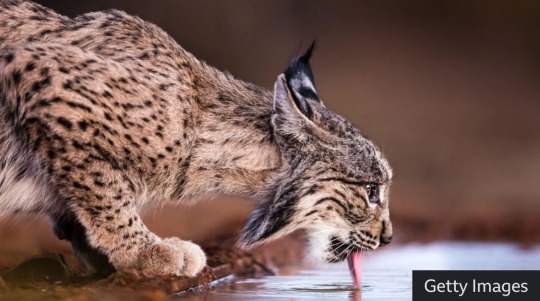
“[The Iberian lynx’s] population grew from 62 mature individuals in 2001 to 648 in 2022. While young and mature lynx combined now have an estimated population of more than 2,000, the IUCN reports. The increase is largely thanks to conservation efforts that have focused on increasing the abundance of its main food source - the also endangered wild rabbit, known as European rabbit. Programmes to free hundreds of captive lynxes and restoring scrublands and forests have also played an important role in ensuring the lynx is no longer endangered.”
3. Planning parenthood for incarcerated men
“[M]any incarcerated young men missed [sex-ed] classroom lessons due to truancy or incarceration. Their lack of knowledge about sexual health puts them at a lifelong disadvantage. De La Cruz [a health educator] will guide [incarcerated youths] in lessons about anatomy and pregnancy, birth control and sexually transmitted infections. He also explores healthy relationships and the pitfalls of toxic masculinity. […] Workshops cover healthy relationships, gender and sexuality, and sex trafficking.”
4. Peru puts endemic fog oasis under protection
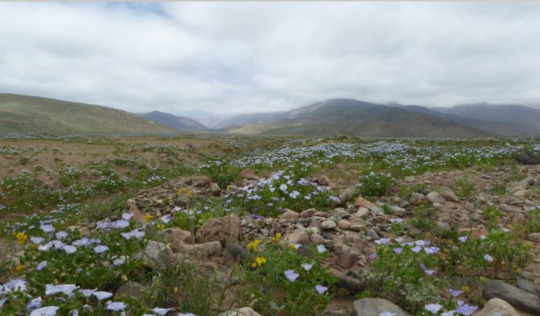
“Lomas are unique ecosystems relying on marine fog that host rare and endemic plants and animal species. […] The Peruvian government has formally granted conservation status to the 6,449-hectare (16,000-acre) desert oasis site[….] The site, the first of its kind to become protected after more than 15 years of scientific and advocacy efforts, will help scientists understand climatic and marine cycles in the area[, … and] will be protected for future research and exploration for at least three decades.”
5. Religious groups are protecting Pride events — upending the LGBTQ+ vs. faith narrative

“In some cases, de-escalation teams stand as a physical barrier between protesters and event attendees. In other instances, they try to talk with protesters. The goal is generally to keep everyone safe. Leigh was learning that sometimes this didn’t mean acting as security, but doing actual outreach. That might mean making time and space to listen to hate speech. It might mean offering food or water. […] After undergoing Zoom trainings this spring, the members of some 120 faith organizations will fan out across more than 50 Pride events in 16 states to de-escalate the actions of extremist anti-LGBTQ+ hate groups.”
6. 25 years of research shows how to restore damaged rainforest
“For the first time, results from 25 years of work to rehabilitate fire-damaged and heavily logged rainforest are now being presented. The study fills a knowledge gap about the long-term effects of restoration and may become an important guide for future efforts to restore damaged ecosystems.”
7. Audubon and Grassroots Carbon Announce First-of-its-Kind Partnership to Reward Landowners for Improving Habitats for Birds while Building Healthy Soils
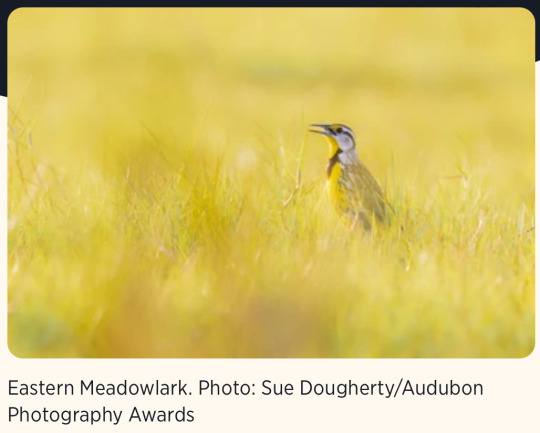
“Participating landowners can profit from additional soil carbon storage created through their regenerative land management practices. These practices restore grasslands, improve bird habits, build soil health and drive nature-based soil organic carbon drawdown through the healthy soils of farms and ranches. […] Additionally, regenerative land management practices improve habitats for birds. […] This partnership exemplifies how sustainable practices can drive positive environmental change while providing tangible economic benefits for landowners.”
8. Circular food systems found to dramatically reduce greenhouse gas emissions, require much less agricultural land
“Redesigning the European food system will reduce agricultural land by 44% while dramatically reducing greenhouse gas emissions from agriculture by 70%. This reduction is possible with the current consumption of animal protein. “Moreover, animals are recyclers in the system. They can recycle nutrients from human-inedible parts of the organic waste and by-products in the food system and convert them to valuable animal products," Simon says.”
9. Could Treating Injured Raptors Help Lift a Population? Researchers found the work of rehabbers can have long-lasting benefits

“[“Wildlife professionals”] tend to have a dismissive attitude toward addressing individual animal welfare,” [… but f]or most raptor species, they found, birds released after rehabilitation were about as likely to survive as wild birds. Those released birds can have even broader impacts on the population. Back in the wild, the birds mate and breed, raising hatchlings that grow up to mate and breed, too. When the researchers modeled the effects, they found most species would see at least some population-level benefits from returning raptors to the wild.”
10. Indigenous people in the Amazon are helping to build bridges & save primates
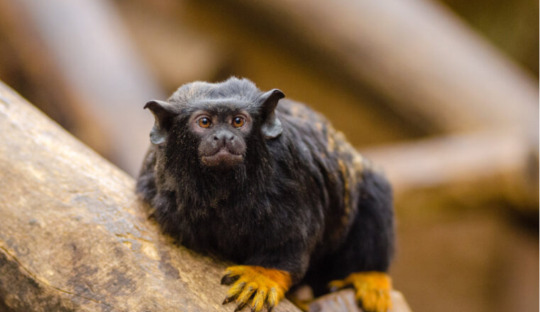
“Working together, the Reconecta Project and the Waimiri-Atroari Indigenous people build bridges that connect the forest canopy over the BR-174 road[….] In the first 10 months of monitoring, eight different species were documented — not only monkeys such as the golden-handed tamarin and the common squirrel monkey (Saimiri sciureus), but also kinkajous (Potos flavus), mouse opossums (Marmosops sp.), and opossums (Didelphis sp.).”
Bonus: A rare maneless zebra was born in the UK
June 8-14 news here | (all credit for images and written material can be found at the source linked; I don’t claim credit for anything but curating.)
#hopepunk#good news#lgbtq#gay rights#gay marriage#same sex marriage#thailand#lynx#big cats#cats#endangered species#endangered#sex education#prison#peru#conservation#habitat#religion#pride#faith#pride month#lgbt pride#compassion#rainforest#birds#nature#climate change#wildlife rehab#wildlife#indigenous
1K notes
·
View notes
Note
did you see te pati maori declared independence??
I DID NOT! Holy shit! Thanks for the news!
Okay, now reporting back from one research deep-dive, the recent context as I understand it is this:
Last November, a conservative right-wing Prime Minister, Christopher Luxon, assumed office. He's got a lot of less than stellar right-wing policies, and that includes making cuts to the Ministry of Social Development and opposing co-governance with the Waitangi Tribunal and other Māori leadership organisations over the administering of public services such as education, health, and infrastructure. He's been openly critical of Māori seats in Parliament, though he hasn't (yet) opposed them. Over the course of his administration, there's been an initiative to omit or cut mentions of the Treaty of Waitangi, the foundational document of New Zealand that forms the basis of arguments for Māori protections, from official language.
Which brings us to yesterday, May 30th. Budget Day. The day the new administration would announce their first budget and a day of mass action for supporters of te Pāti Māori protesting the treatment of Māori under the new government. I don't have any concrete numbers, but RNZ reports thousands of protestors, while the NZ Herald estimates "tens of thousands" turning out nation-wide, and a walking protest that delayed rush-hour traffic in Auckland for hours.
You may have already guessed that the budget was Bad. As I understand it, the budget effectively cut any kind of targeted funding for Māori health or education, and decreased funding for Māori cultural festivals and celebrations. And again, I cannot stress enough how much I am not an expert on this topic, so there's probably a lot more in there I don't know about.
In response to the new budget, Māori Party MP Rawiri Waititi issued a Declaration of Independence to the New Zealand Parliament, (video of his speech in link) with the support of his fellow te Pāti Māori co-leader Debbie Ngarewa-Packer.
There doesn't seem to be any concrete plan in place yet for the organisation of the new Māori parliament, but MPs Waititi and Ngarewa-Packer met with protestors to collect signatures for the Declaration, which they plan to bring to a hui taumata (meeting of congress) today, Friday, May 31st. The text of the Declaration can be found on te Pāti Māori website, in the form of a petition. You do not have to be Māori to sign, but I believe you do have to be kiwi.
#damn this is exciting!!#I'm sure I don't understand the full context of what's happening right now#maybe the party is determined to see this through#maybe it's a show of Māori political power intended to force the coalition government out of its conservative nose-dive#I don't fucking know!!#but I am very hopeful and excited to see what kind of future te Pāti Māori intends for Aotearoa#fucking power move#indigenous rights#politics#Māori
2K notes
·
View notes
Text

"hey how's it going"
#caring about environmental conservation and indigenous fauna and uh#mass transit#is antithetical to the leftist directives#???#marge have you ever actually read this thing
956 notes
·
View notes
Text

#TheRavenKeeper
I'm still very busy but I always have the time between 2 trails for a quick stop to say hi.
So Hi Folks! And hope you all having a good day so far.
#The Raven Keeper#Mohawk Territory#Traditional Homeland#Mohawk Native Reserve#Sacred Land#Native Indigenous#Red Power Movements#Wildlife Need Protection#IUCN#International Union for Conservation of Nature#ECCC#Environment and Climate Change Canada#NCC#Nature Conservancy of Canada#Raw Nature#Nature Photography#Nature Canada#Wildlife Photography#Mountainous Parts of the Northern Hemisphere#Canada#The RavenKeeper
369 notes
·
View notes
Text
Only four months after dams blocking migration were removed, the first Chinook salmon traveled 230 miles to return to the Klamath River Basin. This was the first fish to come home to their ancestral migration routes since 1912.
Over 100 years shut out and it only took them four months to return home once they had the chance.
From the article:
“The return of our relatives the c’iyaal’s is overwhelming for our tribe. This is what our members worked for and believed in for so many decades,” said Roberta Frost, Klamath Tribes Secretary. “I want to honor that work and thank them for their persistence in the face of what felt like an unmovable obstacle. The salmon are just like our tribal people, and they know where home is and returned as soon as they were able[.]"

#hope#good news#dam removal#salmon conservation#river conservation#indigenous conservation#endangered species#environment#biodiversity#hopepunk#chinook salmon#salmon migration#habitat restoration
2K notes
·
View notes
Text
#good news#environmentalism#bison#buffalo#rewilding#revitalization#tatanka#environment#nature#animals#conservation#prarie#indigenous people#indigenous conservation#indigenous stewardship#science#climate change#usa#climate crisis
48 notes
·
View notes
Text
Three words: Dam removal WORKS.
In fact, it works immediately. The day after the dam removal on the Klamath River was completed, an effort spearheaded by the Yurok and other indigenous people of the area, salmon were seen swimming upstream past the old dam site. It didn't take years, or months, or even days. It took hours.
And now salmon can access plenty of historic habitat that was locked away for many years. This is a huge development, because habitat loss is the single biggest cause of species endangerment and extinction. Every time--every time--we restore a species' habitat, we give them a better chance to survive the multi-pronged environmental onslaught we've been subjecting them to.
Even if that habitat is imperfect, if it offers them food, shelter, and opportunities to safely reproduce. Nestled within an intricate network of relationships with other species that took thousands of years to develop, these salmon now have a better chance of weathering the years to come. Long live the salmon!
#salmon#dam removal#Klamath River#Yurok#landback#indigenous rights#nature#wildlife#animals#ecology#environment#science#conservation#scicomm#fish#fishblr#habitat restoration#restoration ecology#endangered species#extinction
366 notes
·
View notes
Text
BC Conservative Leader John Rustad has condemned comments by one of his candidates who could still win a seat in the legislature and would be critical to his chances of forming government. Marina Sapozhnikov finished a very close second to the NDP candidate in Juan de Fuca-Malahat, triggering a recount. Sapozhnikov was recorded making racist comments about Indigenous Peoples during an election night interview with Vancouver Island University student Alyona Latsinnik, who shared the recording with Global News.
Continue Reading
Tagging: @newsfromstolenland
#racism#conservatives#conservative party#indigenous#first nations#bc election#british columbia#cdnpoli#canadian news#canadian politics#canada
178 notes
·
View notes
Text
The Klamath River’s salmon population has declined due to myriad factors, but the biggest culprit is believed to be a series of dams built along the river from 1918 to 1962, cutting off fish migration routes.
Now, after decades of Indigenous advocacy, four of the structures are being demolished as part of the largest dam removal project in United States history. In November, crews finished removing the first of the four dams as part of a push to restore 644 kilometres (400 miles) of fish habitat.
“Dam removal is the largest single step that we can take to restore the Klamath River ecosystem,” [Barry McCovey, a member of the Yurok Tribe and director of tribal fisheries,] told Al Jazeera. “We’re going to see benefits to the ecosystem and then, in turn, to the fishery for decades and decades to come.” ...
A ‘watershed moment’
Four years later, [after a catastrophic fish die-off in 2002,] in 2006, the licence for the hydroelectric dams expired. That created an opportunity, according to Mark Bransom, CEO of the Klamath River Renewal Corporation (KRRC), a nonprofit founded to oversee the dam removals.
Standards for protecting fisheries had increased since the initial license was issued, and the utility company responsible for the dams faced a choice. It could either upgrade the dams at an economic loss or enter into a settlement agreement that would allow it to operate the dams until they could be demolished.
“A big driver was the economics — knowing that they would have to modify these facilities to bring them up to modern environmental standards,” Bransom explained. “And the economics just didn’t pencil out.”
The utility company chose the settlement. In 2016, the KRRC was created to work with the state governments of California and Oregon to demolish the dams.
Final approval for the deal came in 2022, in what Bransom remembers as a “watershed moment”.
Regulators at the Federal Energy Regulatory Commission (FERC) voted unanimously to tear down the dams, citing the benefit to the environment as well as to Indigenous tribes...
Tears of joy
Destruction of the first dam — the smallest, known as Copco 2 — began in June, with heavy machinery like excavators tearing down its concrete walls.
[Amy Cordalis, a Yurok Tribe member, fisherwoman and lawyer for the tribe,] was present for the start of the destruction. Bransom had invited her and fellow KRRC board members to visit the bend in the Klamath River where Copco 2 was being removed. She remembers taking his hand as they walked along a gravel ridge towards the water, a vein of blue nestled amid rolling hills.
“And then, there it was,” Cordalis said. “Or there it wasn’t. The dam was gone.”
For the first time in a century, water flowed freely through that area of the river. Cordalis felt like she was seeing her homelands restored.
Tears of joy began to roll down her cheeks. “I just cried so hard because it was so beautiful.”
The experience was also “profound” for Bransom. “It really was literally a jolt of energy that flowed through us,” he said, calling the visit “perhaps one of the most touching, most moving moments in my entire life”.
Demolition on Copco 2 was completed in November, with work starting on the other three dams. The entire project is scheduled to wrap in late 2024.
[A resilient river]
But experts like McCovey say major hurdles remain to restoring the river’s historic salmon population.
Climate change is warming the water. Wildfires and flash floods are contaminating the river with debris. And tiny particles from rubber vehicle tires are washing off roadways and into waterways, where their chemicals can kill fish within hours.
McCovey, however, is optimistic that the dam demolitions will help the river become more resilient.
“Dam removal is one of the best things we can do to help the Klamath basin be ready to handle climate change,” McCovey explained. He added that the river’s uninterrupted flow will also help flush out sediment and improve water quality.
The removal project is not the solution to all the river’s woes, but McCovey believes it’s a start — a step towards rebuilding the reciprocal relationship between the waterway and the Indigenous people who rely on it.
“We do a little bit of work, and then we start to see more salmon, and then maybe we get to eat more salmon, and that starts to help our people heal a little bit,” McCovey said. “And once we start healing, then we’re in a place where we can start to help the ecosystem a little bit more.”"
-via Al Jazeera, December 4, 2023
#indigenous#river#riverine#ecosystem#ecosystem restoration#klamath#klamath river#oregon#california#yurok#fishing#fisheries#nature is healing#literally this time lol#united states#dam removal#climate change#conservation#sustainability#salmon#salmon run#water quality#good news#hope#rewilding#ecology#environment
5K notes
·
View notes